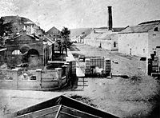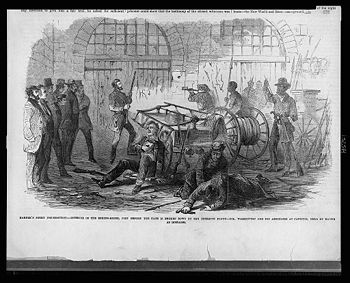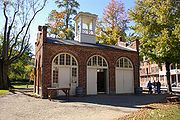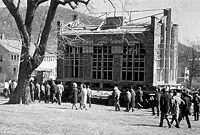
John Brown's Fort
Encyclopedia

Harpers Ferry Armory
Harpers Ferry Armory, more formally known as the United States Armory and Arsenal at Harpers Ferry, was the second federal armory commissioned by the United States government located in Harpers Ferry, West Virginia , the first federal armory being the Springfield Armory located in Springfield,...
in Harpers Ferry, West Virginia
Harpers Ferry, West Virginia
Harpers Ferry is a historic town in Jefferson County, West Virginia, United States. In many books the town is called "Harper's Ferry" with an apostrophe....
, then a part of Virginia
Virginia
The Commonwealth of Virginia , is a U.S. state on the Atlantic Coast of the Southern United States. Virginia is nicknamed the "Old Dominion" and sometimes the "Mother of Presidents" after the eight U.S. presidents born there...
.
An 1848 military report described the building as "An engine and guard-house 35? x 24 feet (7.3 m), one story brick, covered with slate, and having copper gutters and down spouts…" The building achieved notoriety during John Brown
John Brown (abolitionist)
John Brown was an American revolutionary abolitionist, who in the 1850s advocated and practiced armed insurrection as a means to abolish slavery in the United States. He led the Pottawatomie Massacre during which five men were killed, in 1856 in Bleeding Kansas, and made his name in the...
's Raid on the Harpers Ferry Armory in 1859.
John Brown's Raid

Abolitionism
Abolitionism is a movement to end slavery.In western Europe and the Americas abolitionism was a movement to end the slave trade and set slaves free. At the behest of Dominican priest Bartolomé de las Casas who was shocked at the treatment of natives in the New World, Spain enacted the first...
and run-away slave
Slavery
Slavery is a system under which people are treated as property to be bought and sold, and are forced to work. Slaves can be held against their will from the time of their capture, purchase or birth, and deprived of the right to leave, to refuse to work, or to demand compensation...
guerrillas
Guerrilla warfare
Guerrilla warfare is a form of irregular warfare and refers to conflicts in which a small group of combatants including, but not limited to, armed civilians use military tactics, such as ambushes, sabotage, raids, the element of surprise, and extraordinary mobility to harass a larger and...
. Beginning their raid the night of October 16, Brown and his small army of 21 men (16 white and 5 black) did initially manage to capture the armory and arsenal and succeeded in taking 60 citizens of Harper's Ferry hostage. However, Brown's plan relied on local slaves joining the insurrection, and none did. The local militia and armed townspeople killed several members of the insurrection and forced Brown to take up position in the fire engine house where Brown's men had placed several of the hostages and prepared a defensive fortification. On the night of October 17, U.S. marines and then Brevet Colonel Robert E. Lee
Robert E. Lee
Robert Edward Lee was a career military officer who is best known for having commanded the Confederate Army of Northern Virginia in the American Civil War....
and his aide J.E.B. Stuart
J.E.B. Stuart
James Ewell Brown "Jeb" Stuart was a U.S. Army officer from Virginia and a Confederate States Army general during the American Civil War. He was known to his friends as "Jeb", from the initials of his given names. Stuart was a cavalry commander known for his mastery of reconnaissance and the use...
arrived in Harper's Ferry to put down Brown's insurrection. The next morning, using a ladder as a battering ram, the marines battered down the door and stormed the fire engine house. One marine was mortally wounded in the attack as well as several of Brown's men. Some of Brown's men managed to escape, but most were captured, including Brown who was stabbed by the marine commander, Lt. Green. The hostages were freed.
John Brown's Fort


World's Columbian Exposition
The World's Columbian Exposition was a World's Fair held in Chicago in 1893 to celebrate the 400th anniversary of Christopher Columbus's arrival in the New World in 1492. Chicago bested New York City; Washington, D.C.; and St...
in Chicago. The building only had 11 visitors and was dismantled and left on a vacant lot after the exhibition. In 1894, a movement was spearheaded by Washington D.C. journalist Kate Field to preserve the building and move it back to Harper's Ferry. Alexander Murphy deeded 5 acres (20,234.3 m²) of his farm as a relocation site, and the Baltimore and Ohio Railroad
Baltimore and Ohio Railroad
The Baltimore and Ohio Railroad was one of the oldest railroads in the United States and the first common carrier railroad. It came into being mostly because the city of Baltimore wanted to compete with the newly constructed Erie Canal and another canal being proposed by Pennsylvania, which...
provided free shipping. Reconstruction of John Brown's Fort on the Murphy farm was completed by November 1895. In 1909, Storer College
Storer College
Storer College was a historically black college located in Harpers Ferry in Jefferson County, West Virginia. It operated from 1865 until 1955.-Storer School:...
in Harper's Ferry bought John Brown's Fort from Alexander Murphy for $900.00 and moved it to the college's campus. In 1960, the National Park Service
National Park Service
The National Park Service is the U.S. federal agency that manages all national parks, many national monuments, and other conservation and historical properties with various title designations...
acquired the building and, in 1968, moved it once more to a location close to its original site, which had been covered by a railroad embankment in 1894. The Fort is now part of the Harpers Ferry National Historical Park
Harpers Ferry National Historical Park
Harpers Ferry National Historical Park is located at the confluence of the Potomac and Shenandoah rivers in and around Harpers Ferry, West Virginia. The park includes land in Jefferson County, West Virginia; Washington County, Maryland and Loudoun County, Virginia. The park is managed by the...
run by the NPS and sits 150 feet from its original location. 39°19′22.95"N 77°43′46.43"W
Alexander Murphy worked with Kate Field to bring the John Brown Fort to his farm in Harpers Ferry, WV. Alexander and Mary Murphy deeded five acres for One dollar ($1.00) for the fort to be placed on his farm from 1895 until 1910. Alexander Murphy became the owner of the fort, he also owned the gates that surrounded the fort. These gates were designed by George Washington. The Murphy Farm was established September 1, 1869, the National Park Service purchased the farm through TPL, December 31, 2002.
August 17, 1906, Murphy allowed over one hundred prominent African-American men and woman to walk past their farm house to the back field to pay homage to John Brown where the fort had been located. WEB DuBois, Lewis Douglas, WT Greener, and others took their shoes and socks off as walking on holy ground. This day is noted as the John Brown Day written by Benjamin Quarles, Allies for Freedom.
The John Brown Museum now houses the original armory Gate and Alexander Murphy's picture. The original armory gate was donated to the NPS by Jim Kuhn, great-great grandson for no money or tax benefit; the remaining gates were donated in 1997.

